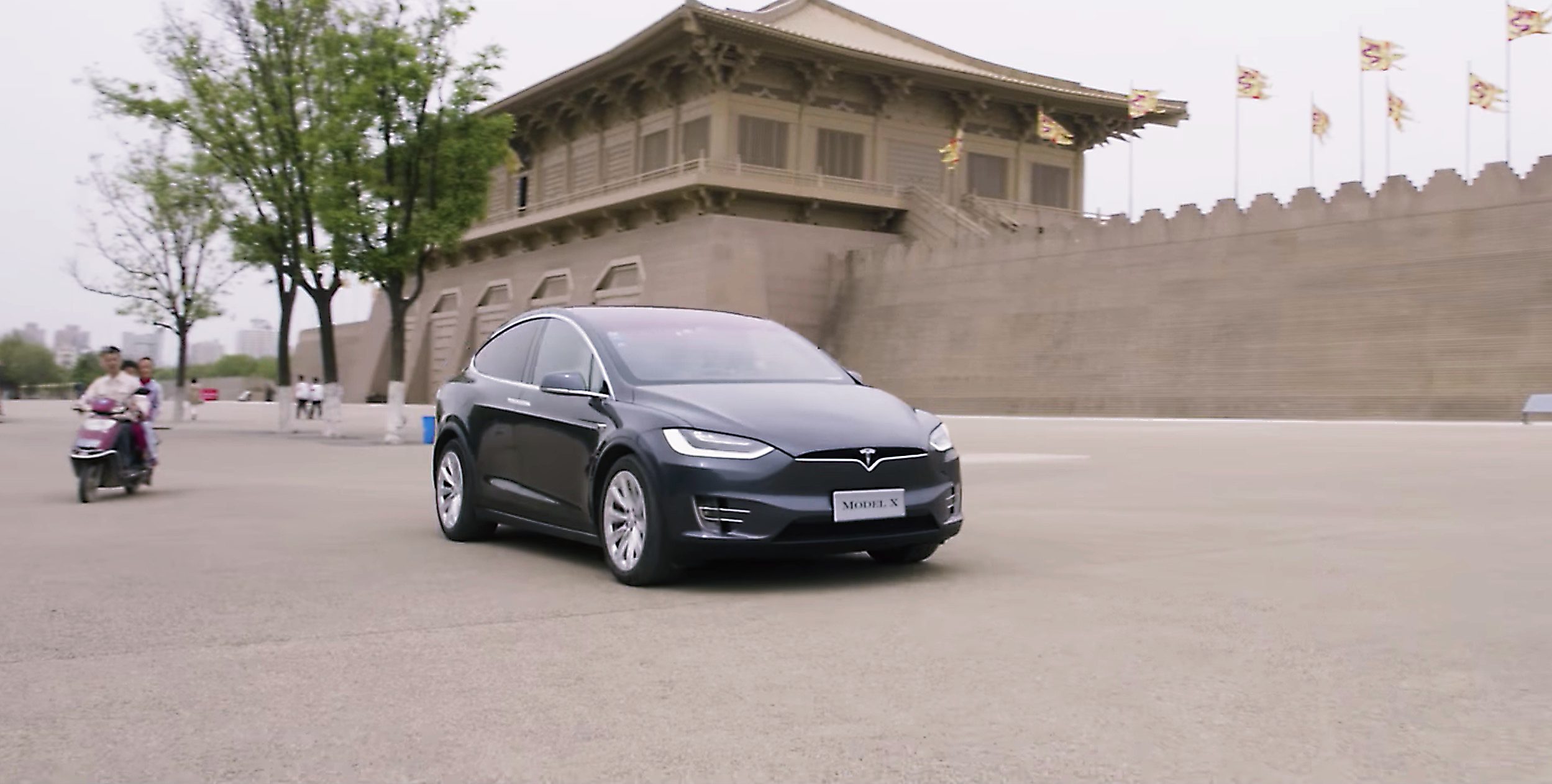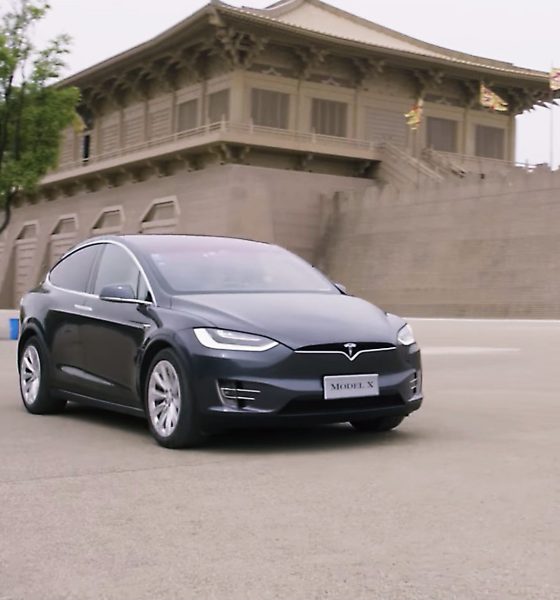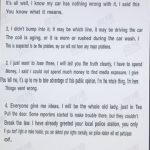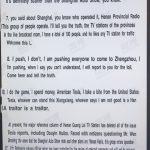Tesla’s battle with the FUD (fear, uncertainty, doubt) campaign in China continues after a Model X owner claims the brakes on his all-electric SUV are faulty. The man was caught admitting that the story is fabricated, telling local media that “I know my car has nothing wrong with it.”
Over the past several months, Tesla has been sparring with owners in China who appear to be a part of an effort to derail the company’s momentum in the country. It all started a couple of months ago at the Shanghai Auto Show when a woman invaded Tesla’s booth at the event by jumping on top of a Model 3 and claiming that her brakes had failed during a drive with her father. The drive ended in an accident, and she blames it on Tesla’s “faulty brakes.”
She was sentenced to serve a few days in jail and has made every attempt to make her case as public as possible. She has gone as far as spraypainting the car as it sat outside of a Tesla showroom in China and has also denied any attempt that Tesla has made to resolve the issue. The automaker published a lengthy statement in May, indicating that it had offered to pay for a third-party company to assess the potential of a brake issue while paying for the study. She denied this and also said that data released by the automaker, which proved that the owner’s father, who was driving the vehicle at the time, traveled at excessive speeds during the journey and also had utilized the brakes successfully many times in the moments leading up to the accident, could have been fabricated or tampered with by Tesla.
The Tesla Model Y is leading China’s electric SUV segment by a wide margin
This hasn’t been the only instance, and those who have decided to turn against the automaker have made it abundantly clear that there will be more attempts in the future to claim that Tesla’s vehicles are faulty and dangerous.
Model X Owner claims faulty brakes, Tesla responds
Now, a Model X owner in China named Mr. Wen is claiming that his vehicle has faulty brakes and is demanding that Tesla provide him with a newly refreshed Model X.
According to a statement on Tesla’s Weibo page, Wen suffered an accident in his vehicle, and Tesla reached out to him to figure out the issue. “At present, the initial remote diagnosis of the cause of the vehicle alarm is the right front wheel speed sensor, and the vehicle used by Mr. Wen at the time of failure…may be due to contamination of the wheel speed sensor or damage to the sensor line,” Tesla said (via @Ray4Tesla). “Mr. Wen’s vehicle has traveled more than 175,000 kilometers, which has exceeded the vehicle warranty.”
Tesla then suggested that the vehicle be towed to a Service Center in China so that it could be examined to determine the reason for failure and fixed properly. However, Wen has continued to drive the car over 800 kilometers, Tesla says, and has gone as far as claiming on the internet “that the vehicle has failed and it was dangerous.”
Tesla says it hopes that Mr. Wen will allow the company to conduct inspections and repair the car so it can be used normally as soon as possible.
Mr. Wen admits to media that “I know my car has nothing wrong with it”
According to Tesla, the blog Teslabot broke a recording of Mr. Wen admitting that the car has no issues. In a series of statements, he said, “I know my car has nothing wrong with it,” and “The coil is aging, or it is worn during the car wash. This is suspected to be the problem, my car will not have any major problems.”
Wen said that he didn’t have money to find media exposure and that “If you don’t make trouble, you can defend your rights normally, our police station will not participate.”
- Credit: Tesla Weibo via @Ray4Tesla
- Credit: Tesla Weibo via @Ray4Tesla
According to the post on Weibo, the media outlet Henan Guan Lei TV has deleted all of the reports of Tesla vehicle issues in China.
Unfortunately, this is not the first time that those who have claimed that Tesla’s vehicles have issues have admitted that their story was fabricated. It’s actually happened on several occasions, with many of the perpetrators admitting that their issues were made up for media attention.
Tesla has also battled falsified and non-verified reports of lackluster sales figures. Most recently, a claim that indicated Tesla’s registrations in China in May had reduced by 50% was shrugged off by the Secretary General of the Chinese Passenger Car Association.
What do you think? Let us know in the comments below, or be sure to email me at joey@teslarati.com or on Twitter @KlenderJoey.

News
Tesla China quietly posts Robotaxi-related job listing
Tesla China is currently seeking a Low Voltage Electrical Engineer to work on circuit board design for the company’s autonomous vehicles.

Tesla has posted a new job listing in Shanghai explicitly tied to its Robotaxi program, fueling speculation that the company is preparing to launch its dedicated autonomous ride-hailing service in China.
As noted in the listing, Tesla China is currently seeking a Low Voltage Electrical Engineer to work on circuit board design for the company’s autonomous vehicles.
Robotaxi-specific role
The listing, which was shared on social media platform X by industry watcher @tslaming, suggested that Tesla China is looking to fill the role urgently. The job listing itself specifically mentions that the person hired for the role will be working on the Low Voltage Hardware team, which would design the circuit boards that would serve as the nervous system of the Robotaxi.
Key tasks for the role, as indicated in the job listing, include collaboration with PCB layout, firmware, mechanical, program management, and validation teams, among other responsibilities. The role is based in Shanghai.
China Robotaxi launch
China represents a massive potential market for robotaxis, with its dense urban centers and supportive policies in select cities. Tesla has limited permission to roll out FSD in the country, though despite this, its vehicles have been hailed as among the best in the market when it comes to autonomous features. So far, at least, it appears that China supports Tesla’s FSD and Robotaxi rollout.
This was hinted at in November, when Tesla brought the Cybercab to the 8th China International Import Expo (CIIE) in Shanghai, marking the first time that the autonomous two-seater was brought to the Asia-Pacific region. The vehicle, despite not having a release date in China, received a significant amount of interest among the event’s attendees.
Elon Musk
Elon Musk and Tesla AI Director share insights after empty driver seat Robotaxi rides
The executives’ unoccupied tests hint at the rapid progress of Tesla’s unsupervised Robotaxi efforts.

Tesla CEO Elon Musk and AI Director Ashok Elluswamy celebrated Christmas Eve by sharing personal experiences with Robotaxi vehicles that had no safety monitor or occupant in the driver’s seat. Musk described the system’s “perfect driving” around Austin, while Elluswamy posted video from the back seat, calling it “an amazing experience.”
The executives’ unoccupied tests hint at the rapid progress of Tesla’s unsupervised Robotaxi efforts.
Elon and Ashok’s firsthand Robotaxi insights
Prior to Musk and the Tesla AI Director’s posts, sightings of unmanned Teslas navigating public roads were widely shared on social media. One such vehicle was spotted in Austin, Texas, which Elon Musk acknowleged by stating that “Testing is underway with no occupants in the car.”
Based on his Christmas Eve post, Musk seemed to have tested an unmanned Tesla himself. “A Tesla with no safety monitor in the car and me sitting in the passenger seat took me all around Austin on Sunday with perfect driving,” Musk wrote in his post.
Elluswamy responded with a 2-minute video showing himself in the rear of an unmanned Tesla. The video featured the vehicle’s empty front seats, as well as its smooth handling through real-world traffic. He captioned his video with the words, “It’s an amazing experience!”
Towards Unsupervised operations
During an xAI Hackathon earlier this month, Elon Musk mentioned that Tesla owed be removing Safety Monitors from its Robotaxis in Austin in just three weeks. “Unsupervised is pretty much solved at this point. So there will be Tesla Robotaxis operating in Austin with no one in them. Not even anyone in the passenger seat in about three weeks,” he said. Musk echoed similar estimates at the 2025 Annual Shareholder Meeting and the Q3 2025 earnings call.
Considering the insights that were posted Musk and Elluswamy, it does appear that Tesla is working hard towards operating its Robotaxis with no safety monitors. This is quite impressive considering that the service was launched just earlier this year.
Elon Musk
Starlink passes 9 million active customers just weeks after hitting 8 million
The milestone highlights the accelerating growth of Starlink, which has now been adding over 20,000 new users per day.

SpaceX’s Starlink satellite internet service has continued its rapid global expansion, surpassing 9 million active customers just weeks after crossing the 8 million mark.
The milestone highlights the accelerating growth of Starlink, which has now been adding over 20,000 new users per day.
9 million customers
In a post on X, SpaceX stated that Starlink now serves over 9 million active users across 155 countries, territories, and markets. The company reached 8 million customers in early November, meaning it added roughly 1 million subscribers in under seven weeks, or about 21,275 new users on average per day.
“Starlink is connecting more than 9M active customers with high-speed internet across 155 countries, territories, and many other markets,” Starlink wrote in a post on its official X account. SpaceX President Gwynne Shotwell also celebrated the milestone on X. “A huge thank you to all of our customers and congrats to the Starlink team for such an incredible product,” she wrote.
That growth rate reflects both rising demand for broadband in underserved regions and Starlink’s expanding satellite constellation, which now includes more than 9,000 low-Earth-orbit satellites designed to deliver high-speed, low-latency internet worldwide.
Starlink’s momentum
Starlink’s momentum has been building up. SpaceX reported 4.6 million Starlink customers in December 2024, followed by 7 million by August 2025, and 8 million customers in November. Independent data also suggests Starlink usage is rising sharply, with Cloudflare reporting that global web traffic from Starlink users more than doubled in 2025, as noted in an Insider report.
Starlink’s momentum is increasingly tied to SpaceX’s broader financial outlook. Elon Musk has said the satellite network is “by far” the company’s largest revenue driver, and reports suggest SpaceX may be positioning itself for an initial public offering as soon as next year, with valuations estimated as high as $1.5 trillion. Musk has also suggested in the past that Starlink could have its own IPO in the future.












